Nakaoki: Kama and Incense
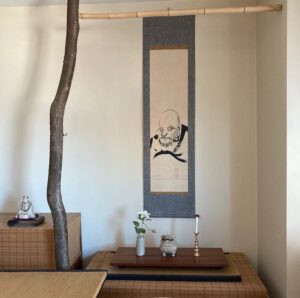
Tokonoma with utensils for a Daruma Memorial Tea. Kake-jiku, 掛軸, hang-scroll, with brushed picture of Daru-ma, 達磨, Attain-polish. Kō-ro, 香炉, incense-hearth, Kara-ji-shi, 唐獅子, Tang-lion-of, Shino-yaki, 志野焼, Aspire-field-fired. Flower in ceramic hana-tate, 花立, flower-stand, ceramic sake bottle, from Kami-ga-mo Jin-ja, 上賀茂神社, Upper-joyous-luxuriant God-shrine. Polished brass hi-tate, 火立, fire-stand, candlestick.
Daru-ma, 達磨, Attain-polish, as Bodhidharma is known in Japan, was the founder of Chan Buddhism in China. He sat meditating in a cave for nine years. Bodhidharma was the 28th founder of Zen Buddhism, counting from Gautama Buddha, who is also regarded as the 28th Buddha. The monthly en-nichi, 縁日, edge-day, for Fu-dō Myō-ō, 不動明王, No-move Bright-king, a wrothful manifestation is the 28th day. Rikyū chose to kill himself on the 28th day of the 3rd lunar month, and is venerated monthly on the 28th day.
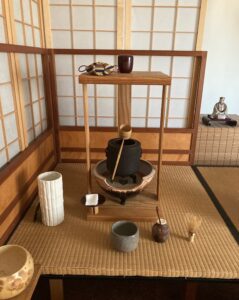
In the realm of Chanoyu, October, the 10th month, the fu-ro, 風炉, wind-hearth, is placed in the middle of the tatami for Tea presentations. The furo may be put on various types of shiki-ita, 敷板, spread-boards, or and shiki-gawara, 敷瓦, spread-tiles, as well as on a variety of display stands, tana, 棚, shelf, or larger dai-su, 台子, support-of. The mizu-sashi, 水指, water-indicate, is placed to the left of the furo, while the other utensils are placed in their usual locations.
There are several reasons why the furo is placed in such a location. In Japan, it is in the 10th month in which the Shintō deities leave their shrines and assemble at Izumo Ta-isha, 出雲大社, Out-cloud Great-shrine, which gives the 10th month the name, Kan-na-zuki, 神無月. God-no-month. Which With the furo in the middle of the tatami, the furo is like a kō-ro, 香炉, incense burner. Although the Shintō kami, 神, god, are away, the Buddhist deities remain in their customary places. It would seem appropriate in such circumstances to have the finest furo, rather than the partially destroyed furo. Perhaps, originally, Urasenke followers used a fine furo, and to be in harmony with the decline of autumn’s nature, they chose to use the timeworn rusted broken down furo.
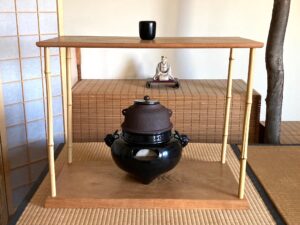
Take dai-su, 竹台子, bamboo support-of, display stand with a ki-men bu-ro, 鬼面風炉, demon-face wind-hearth, placed in the center of the baseboard, Naka-oki, 中置, Middle-place. A Rikyū-gata chū-natsume, 利休形中棗, Rikyū-form middle-jujube, tea container is displayed on the top shelf.
The pictured take daisu is the choice of Rikyū, which is smaller than the original, which is about the size of the shin daisu, that spans the width of the tatami. The larger take daisu is associated with Rikyū’s teacher Take-no Jō-ō, 武野紹鴎, War-field Help-gull. The pictured take daisu boards are made of kiri, 桐, paulownia, and measure 2 x 1 shaku kujira-jaku. The bottom shelf is called the ji-ita, 地板, earth-board, and the top shelf is called the ten-ita, 天板, heaven-board. The wood grain of the tenita is from right to left ←, the wood grain of the jiita is from left to right →. The back right post is identified with the start of spring, near right is start of summer, near left autumn, back left winter. The plain naturalness of the bamboo daisu emphasizes the Shintō aspect of Japan, whereas the black-lacquered shin daisu evokes the Buddhist aspect that came from China.
The ki-men bu-ro, 鬼面風炉, demon-face wind-hearth, is made of bronze, the kama, 釜, kettle, is made of iron. The kama has a flaring hane, 羽, wing, around its middle classifies it as a kiri-kake, 切掛, cut-hang, or kiri-awase bu-ro, 切り合わせ風炉, cut-gather wind-hearth.
The kama lugs, with rings in the creatures’ mouths, are called kan-tsuki, 鐶付, metal ring-attach. The rings indicate that the furo is portable, even while it is hot from the charcoal fire within. However, one is trained to resist picking the furo up with the rings. Some old, iron furo have detachable iron rings. The form of each lug is named ki or oni, which is a demon. However, some forms resemble the stylized head of a ‘phoenix’, hō-ō, 鳳凰, male and female mythical birds, originating in China. These auspicious birds are usually depicted in pairs, as the name indicates. Such a pair adorns the roof of the Hō-ō-dō, 鳳凰堂, ‘Phoenix’-hall, of the Byō-dō-in, 平等院, Peace-equal-sub-temple, in Uji. The world renown temple is dedicated to Amida.
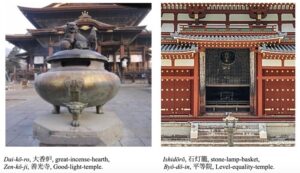
Dai-kō-ro, 大香炉, great-incense-hearth, at Zen-kō-ji, 善光寺, Benevolent-light-temple, Naga-no, 長野, Long-field. Zenkōji is both Ten-dai-shū, 天台宗, Heaven-support-sect, and Jō-do-shū, 浄土宗, Pure-land-sect. The image of Amida is within the building facing the incense burner. Stick incense emits a glowing red ember. In Buddhism, having an incense burner at the entrance to a temple and before an image of the deity, is equated with a lantern and its light of an oil lamp. The lantern at Byōdōin is made of stone, while other lanterns may be made of Kara-kane, 唐銅, Tang-copper, bronze, such as the lantern at Tō-dai-ji, 東大寺, East-great-temple, in Nara. In the roji garden of a Tearoom, the ishidōrō is the most often the chosen style.
Dai-kō-ro, 大香炉, great-incense-hearth, at Zen-kō-ji, 善光寺, Benevolent-light-temple, Naga-no, 長野, Long-field, was built in the 7th century. Zenkōji is said to hold Japan’s oldest buddha statue, A-mi-da Nyo-rai, 阿弥陀如来, Praise-increase-steep Like-become, which is the temple’s principal image. The bronze image of Amida, cast in 1254, is the central figure of an Amida San-zon, 三尊, Amida Three-lords: with Seishi Bosatsu and Kannon Bosatsu, which is identified with the Rai-go, 来迎, Come-welcome, guiding souls to his wester paradise of Jō-do, 浄土, Pure-land.
The temple’s dai-kō-ro, 大香炉, Great-incense-burner, has three lion head-like feet, and a lid with a lion-like creature, Kara ji-shi, 唐獅子, Tang lion-child, its left paw on a fortune tama, 玉, ball. The sacred burner is raised on a stone platform. The smoke from the burning offerings of sen-kō, 線香, thread-incense, is rubbed onto one’s body for good health and fortune.
Ishi dō-rō, 石灯籠, stone lamp-basket, Hō-ō-dō, 鳳凰堂, ‘Phoenix’-hall, Byō-dō-in, 平等院, Level-equality-temple, A-mi-da Nyo-rai, 阿弥陀如来 face seen through screen opening. An oil lamp is placed within the stone lantern.
The creatures that are part of various objects and utensils are usually identified as lions. Many are not, they may be one of the nine sons of the Dragon King: Ryū-o Kyū-shi, 龍生九子, Dragon-born Nine-child. The Dragon King lives in the sea, so that his sons provide protection from fire. Each of the nine has a particular function. The ‘lion’ on the lid of the incense burner is one of the nine sons, Suan Ni, 狻猊, (fabulous lion), likes smoke and fire. The face and paw of the three feet of the burner are also identified with Suan Ni, who likes smoke and fire, and likes to sit and stay quiet. The ball under the paw of the ‘lion’ on the daikōro pictured above may be likened to the tsumami, 摘み, pinch, knob on the lid of the kama.
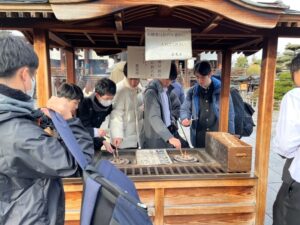
Students from Kagoshima Prefecture High School purchasing and lighting bundles of temple offering sen-kō, 線香, stick-incense, at Zenkōji. From Kagoshima on Kyūshū to Nagano on Honshū is 1227 km, and about 9 hours by ‘bullet train’, with transfers.
A bundle of senkō is purchased for 100 yen – the coins are dropped into the wooden grilled box. The bundle is lit from a fire in the stand and then stood upright in the bed ash of the great kōro nearby. A variety of temple incense is available to purchase and burned at home or elsewhere. This is a custom at temples across Japan.
Sen-kō, 線香, stick-incense is burned for enjoyment and as an offering. In Buddhism, the number of sticks varies between sects from one, two, and three. Jō-do-shū, 浄土宗, Pure-land-sect, burns one and three sticks of senkō. Jō-do Shin-shū, 浄土真宗, Pure-land True-sect, breaks one stick into two or three sticks and lays them sideways. Placing incense sticks on its side is called ne-sen-kō, 寝線香, sleep-stick-incense, and the burning end lit side should be toward the left.
Zenkōji senkō: box quantity – 180 sticks L. 5.6 sun kane-jaku or 4.48 sun kujira-jaku (14 cm.): made of a blend of kyara, agarwood, and sandalwood; cost approximately $15. One of several varieties sold by the temple. Although senkō is not customarily burned at a Tea gathering, Japanese Buddhists burn incense, usually senkō, every day in remembrance of departed souls.
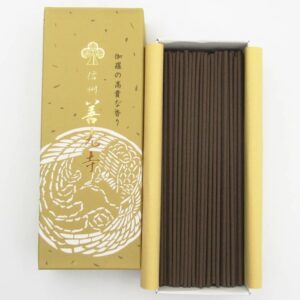
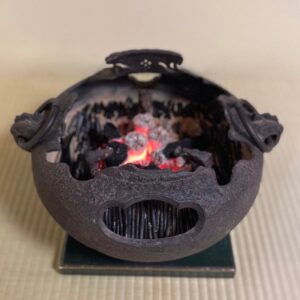
Yatsure bu-ro, 窶れ風炉, timeworn wind-hearth, the ash bed covered with carefully aligned wara-bai, 藁灰, straw-ash. Photo courtesy of Senshuan, 千秋庵, Urasenke, Tōkyō.

The Dai-kōro at Zenkōji is raised on a stone platform, which is common at many temples. It may be one of the reasons why an iron furo is often raised on ceramic tile, 敷瓦, spread-tile. Perhaps the blackened rice straw, wara-bai, 藁灰, straw-ash, in the furo suggests the burnt remains of the offered sen-kō, 線香, line-incense, in the kōro.
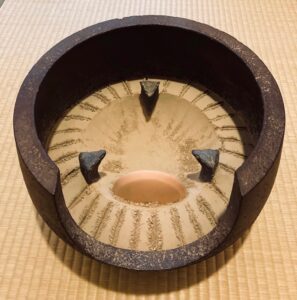
Dō-an Bu-ro, 道安風炉, Way-peace Wind-hearth, also called tetsu bu-ro, 鉄風炉, iron wind-hearth, with wide hi-mado, 火窓, fire-window, go-toku, 五徳, five-virtue, in an ash bed with 29 scored lines, maru-bai, 丸灰, circle-ash.
In Buddhism, Gautama was the 28th Buddha. Ji-zō Bo-satsu, 地蔵菩薩, No-move Grass-buddha, is guardian of the world until the arrival of the Future Buddha, Maitreya, Jpn. Mi-roku Bo-satsu, 弥勒菩薩, Increase-rein Grass-buddha, who will be the 29th Buddha.
In the realm of Chanoyu, it is said that the front of the furo, the shō-men, 正面, correct-face, faces the teishu. The teishu faces north the seat of deity, which means that the true furo shōmen faces deity. In this circumstance, the true shōmen faces deity. When the furo has a gotoku, the single tsume opposite the teishu is toward deity, which means the single line at the tsume may represent Miroku the 29th Buddha.
The Kanji 正 is also read sei, which is nearly an infinite number: ten thousand undecillion: 10 to the 40th power. It is also a means of tallying five units, like tallying with the five fingers.
In Buddhism, a Sei-ja, 聖者, Holy-person, will have seven lives in the human world, and seven lives in the heavenly world. If such a person passes through 14 lives in a state of intermediate existence between death and life, from the end of one life to the next life, and 28 lives in total, there will be a further 29th life.
The number 29 is significant in Buddhism because it is the age at which Siddhartha Gautama, the founder of Buddhism, left his sheltered life as a prince to search for enlightenment.
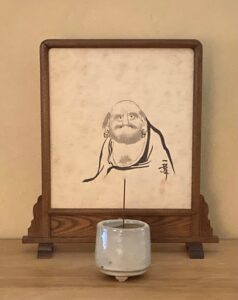
Shiki-shi, 色紙, color-paper, pasteboard with brush drawing of an image of Daruma, signed Ichi-i, 一葦, One-reed. leaf; 9 x 8 sun kane-jaku, mounted in a shikishi tate, 立, stand, made of kuwa, 桑, mulberry. Ratio of 8÷9 is 8.888 to infinity.
Kō-ro, 香炉, incense-hearth, stoneware cup with three feet, and clear glaze; h. 2.6 sun kane-jaku, China. Contains ash with a single sen-kō, 線香, stick-incense, standing upright.
Senkō is made in a wide variety lengths, thicknesses, and shapes, and are selected for the fragrance as well as the length of time that each stick burns. This is a major aspect with regard to the length of time for sei-za, 正座, correct-sit, sitting meditation. The times of burning a piece of incense vary from several minutes, hours, and some lengthy coils suspended in temples may burn for days.
Incense, o-kō, お香, hon.-incense, has been greatly appreciated in Japan since ancient times. Dedication and practice is called Kō-dō, 香道, Incense-way. According to custom, one does not ‘smell’ incense, but ‘listens’ to it, which is called kō wo kiku, 香を聞く, incense to listen, and mon-kō, 聞香, listen-incense. There is, in Japanese, a profound wordplay on ‘kiku’, which means both listen, 聞, and listen, and chrysanthemum, 菊. Burning incense very rarely makes a sound, however, traditionally, the incense burner is brought to the nose, and one inhales through the nose, three times, one should turn their head away when exhaling through the nose, so that one’s breath does not blow away the ash or even the tiny piece of incense. The action appears as though one is listening to the incense.
The radiating lines in the ash bed of the kōro are like the many petals of the chrysanthemum. The chrysanthemum is Japan’s imperial crest – Kiku no Go-mon, 菊の御紋, Chrysanthemum’s Hon.-crest. The imperial crest has 16 radiating petals, which is symbolic of Infinity is Space. A variation has an additional 16 petal tips between the primary 16, which creating 32 petals. This is part of the origins of the symbolic nature of the number 33, as in the 33 manifestations of Kan-non, 観音, See-sound, the Buddhist goddess of mercy. The center of the flower represents the sun, which heats the world. Perhaps the lines radiating out from the circular piece of burning charcoal represents the sun. In Buddhism, the sun is identified with Dai-nichi, 大日, Great-sun, who is the universe made manifest.
Uttering the words of the jiku bring them into existence, just as burning incense brings the fragrance into existence. Both word and fragrance are invisible, which are identified as positive, Yō, 陽, and the written word and incense pieces are themselves aspects of negative In, 陰.
The words written on the kakejiku must be heard to exist. The first words spoken in the Tearoom during a Chaji, is the shōkyaku saying to the teishu who is outside of the entrance of the Tearoom, ‘Dōzo wo hairi kudasai’, どうぞお入りください, Please enter if you will. After introductions, the shōkyaku asks the teishu to read the writing on the kakejiku. Thereby, the word, Yō, Yang, comes into existence.

Kiki gō-ro, 聞香炉, listen incense-hearth, porcelain with three feet, and blue some-tsuke, 染付, dye-attach, design. In the conical ash bed is a buried piece of burning kō ta-don, 香炭団, incense charcoal-round. Patterns are varied in the kōro, and a formal design, as pictured, has five sections of ten impressed lines, with a piece of kō-boku, 香木, incense-wood, placed on a gin-yō, 銀葉, silver-leaf, square of mica with a silver border. Utensil of Shino school of incense.
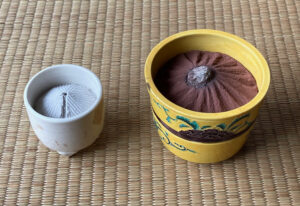
In the above picture on the left is a kō-ro, 香炉, incense burner, and on the right is a hi-ire, 火入, fire-receptacle, to light tobacco.
The pictured kō-ro, 聞香炉, incense-hearth, is more correctly called a kiki gōro, that is adapted from Kō-dō, 香道, Incense-way. It is a ceramic cup with three feet, by Makoto Ya-be, 誠矢部, Truth Arrow-guild. It contains ash with impressed radiating lines, that may also be made smooth with the single line, kiki-suji, 聞線, listen-line. The kikisuji and one foot determines the shō-men, 正面, correct-face, and the center hole provides direct heat from the buried kō ta-don, 香炭団, incense charcoal-round.
The hi-ire, 火入, fire-receptacle, to light tobacco, has its origins in the kōro; tobacco is a kind of incense. Smoking tabako, 煙草, burn-grass, has been exceedingly popular in Japan for centuries. The presence of smoking articles held on a tabako bon, 煙草盆, is a sign for relaxation in the Tearoom. Handling the pipe allows the guest to be master of fire, shu, 主, as in teishu, 亭主. The guest is the master of fire.
The pictured hiire is a ceramic cup with yellow glaze and purple and green floral designs, ki-Go-chi, 黄交趾, yellow Mingle-remains. The cup is filled with hishi-bai, 菱灰, caltrop-ash, that has casually radiating impressed lines. The charcoal is exposed, rather than buried in the ash as with an incense burner, because tobacco is lit from the burning charcoal.
Incense is intrinsic to Chanoyu, and should be burned in the Tearoom. Sandalwood, byaku-dan, 白檀, is burned with the fu-ro, 風炉, wind-hearth, and blended aromatics, neri-kō, 練香, kneaded-incense, are burned with the ro, 炉, hearth.
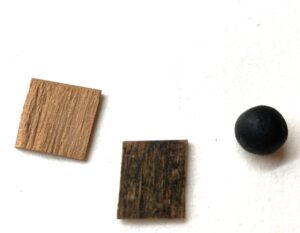
From left: chip of byaku-dan, 白檀, white-sandalwood, .5 sun kane-jaku; chip of byakudan rubbed with neri-kō, 練香, kneaded-incense, technique called tsuke-boshi kō, 付干し香, attach-dry incense; ball of neri-kō, 練香, kneaded-incense, used with the ro, 炉, (sunken) hearth.
A Na-gori Cha-ji, 名残の茶事, Name-remain Tea-matter, is held at the end of the furo season, all of the remaining tea of the year is drunk, the remaining hi-ga-shi, 干菓子, dry-sweet-of, are offered. The same is true for all of the year’s incense. Tsuke boshi kō, 付干し香, attach-dry incense, is commonly made by rubbing neri-kō, 練香, knead-incense, which is burned with ro, the sunken hearth, onto the square chips of byaku-dan. O-yose kō, お寄せ香, hon.-choose incense, is generally made by grinding up all different kinds of incense from the year, which are pasted together, and burnt in the furo.
There are a great variety of incense containers that can be used with the furo. Rikyū, in poem 64 of his One Hundred Poems, Ri-kyū’s Hyaku-shū, 利休百首, Rich-quit ’s Hundred-neck, he lists utensils for building the charcoal fire in the furo:
Kin-zoku no hi-bashi nuri-mono no kō-gō byaku-dan to chū-goku yu-rai no mono wo tsukaimasu.
金属の火箸 塗物の香合 白檀と中国由来の物を使います。
Metal-made ’s fire-rods lacquered-thing’s incense-gather white-sandalwood Middle-country (China) wherefore-from to use.
It is quite significant that Rikyū refers to use of ‘Chinese’ utensils with the furo. With the decline of nature in the 10th month, the choice of kōgō should be in keeping with the season.
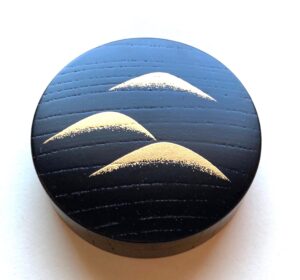
Kō-yama kōgō, 遠山香合, Distant-mountain incense-gather; named ‘Ninju Kōgō’, 仁寿香合, Benevolence-virtue Incense-gather; round, black-lacquered covered container made of kuwa, 桑, paper mulberry, with gilt design of three distant mountains; diam. 2.4 sun kane-jaku, by Mae-hata Shun-sai, 前端春斎, Fore-edge Spring-abstain, Kaga. Choice of Gen-gen-sai, 玄々斎, Mystery-mystery-abstain, 11th Iemoto, Urasenke, Kyōto. The name nin-ju, 仁寿, is taken from the Analects of Confucius: the wise enjoy rivers, the virtuous enjoy mountains. Souvenir of 60th anniversary of Urasenke, and 30th anniversary of the Urasenke Branch, San Francisco, Calif.
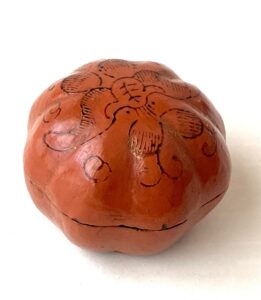
Hisago kō-gō, 瓢香合, gourd incense-gather; dried natural gourd with black lacquered design of a butterfly, China; diam. 2 sun kane; the eight-lobe form is emblematic of Infinity in Space: the Japanese Kanji for the number eight is hachi, 八, which is described as sue-hiro, 末広, ends-wide. This is similar to the western symbol and concept for infinity.
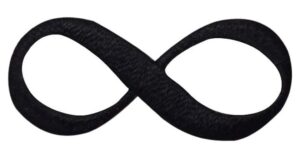
The western symbol for infinity, the lemniscate, is both a symbol of the eternal, the vastness, and it also can be representative of duality.
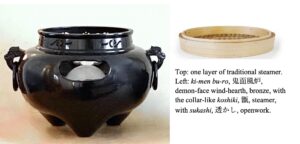
Because the furo had lost its supporting collar, koshiki, 甑, steamer, it no longer is able to support the kama. Without the support of the collar, the kama required a device to support the kama, and the familiar choice was a trivet-like iron go-toku, 五徳, five-virtues. The gotoku was traditionally used with the ring up. Rikyū is credited with placing the three tsume, 爪, of the gotoku upright in the furo, and the sunken ro, to support the kama.
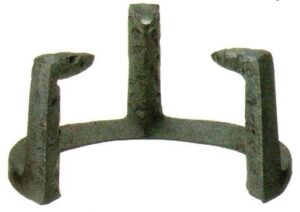
Go-toku, 五徳, five-virtues, tetsu, 鉄, iron, with 3 tsume, 爪, talons, and a two/thirds of a ring, made for fu-ro, 風炉, wind-hearth. The absence of the third of the ring allows space for the placement of the mae-kawarake, 前土器, fore-earth-container.
Ancient iron furo were used a great deal and over the years they rusted and came apart. The large kama, 釜, kettles, were treasured, and used in the sunken hearth ro. Because the broken down furo was treasured, it was often used in the 10th month to be in harmony with the decline of autumn. In time, commercial industry prompted artists to create variations of the yatsure buro. The history of Chinese statues of the Buddha made of iron post-date the migration of the Buddhist religion into ancient China. Iron Buddha statues, tetsu-Butsu, 鉄仏, play an interesting role in Chinese beliefs and spirituality. For a Buddhist, the iron Buddha statue is typically an altar centerpiece. In feng shui, it is believed that an iron Buddha will increase the flow of chi where it is enshrined, and bring prosperity and great fortune to those in the home or temple.
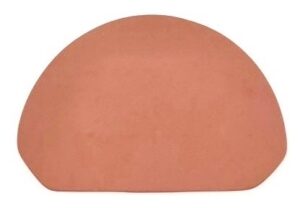
Mae-kawara-ke, 前土器, fore-earth-container, aka, 赤, red, made for use with a tetsu bu-ro, 鉄風炉, iron wind-hearth. In Japanese, the tile is called han-getsu kata, 半月形, half-moon shape. The color red is identified with the South.
The mae-kawarake may be seen as either the sun or the moon. In Buddhism, the moon represents the Pure Land paradise of Amida. This can be seen in thangka designs, in which the Buddha is typically seen in the upper right corner, pointing towards the moon, which is usually located in the upper left corner of the design. Buddha pointing at the moon often symbolizes the release from the cycles of rebirth.
One of the words for dawn is akatsuki, 暁, which sounds like aka tsuki, that could mean 赤月, red moon. Akatsuki does refer to the dim light before the sun rises. In the old days, the time change from midnight to dawn was divided into akatsuki, shino-no-me, 夜の明, night ’s clear, and akebono, 曙, dawn.
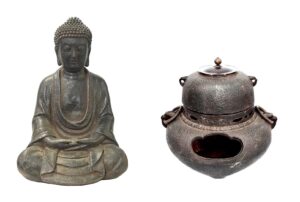
Left: figure of Ami-da Nyo-rai, 阿弥陀如来, Praise-increase-steep Like-become, rough patinated iron. Right: Tetsu bu-ro, 鉄風炉, iron wind-hearth, and kama, 釜, kettle, with rough patina.
Iron Buddhas that were once covered with gold, often fell victim to soldiers and vandals who stripped them of gold, leaving them subject to weathering and rusting.
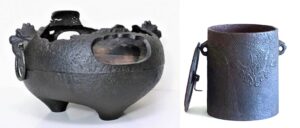
Yatsure bu-ro, 窶風炉, timeworn wind-hearth, un-ryū gama, 雲龍釜, cloud-dragon kettle.
Yatsure bu-ro, 窶風炉, timeworn wind-hearth, iron, is also a ki-men bu-ro, 鬼面風炉, demon-face wind-hearth, created to appear aged and partially deteriorated. Only a small part of the koshiki has been retained. The kama is placed on a gotoku in the ash bed of the furo, so that the top of the kama is one half the height of the furo from the top of the koshiki. The gotoku would be only partially visible. That would give the impression of the full height of the furo/kama in its original state. Note the seam around the middle of the furo which is approximately halfway between the bottom and the top of the koshiki. This location of the seam affirms the three-division aspect of the furo/kama.
The height of a standard modern kimen buro, excluding the lid tsumami/knob is 9.5 sun kujira-jaku. The number 9.5 in Japanese is kyū-go, which is a homonym for 救護, salvation-protection. The ratio between the height of the furo collar, koshiki, and the visible portion of the kama is 2:1. The entire furo/kama is divided into thirds.
The yatsure buro may retain part of the koshiki, which indicates where the kama would rest. If a standard kama that is used with the yatsure buro is placed so that the hane or its remnant were to be placed as though resting on the koshiki, would make the gotoku greatly revealed. This would be unacceptable. Therefore, selection of the kama for a yatsure buro must take into consideration the visibility of the gotoku. A popular style of kama for the yatsure buro is cylindrical or is one that has no hane or obvious haochi. One kama that is often chosen is Rikyū’s un-ryū gama, 雲龍釜, cloud-dragon kettle. A reason that the unryū gama may be ideal is that it has an image of dragon, and its kantsuki are dragon heads. The old iron furo has dragon head kantsuki. Collectively, the furo and kama have five dragon motifs.
In Buddhism, there are the Go-ryū, 五龍, Five-dragons, which have many manifestations. The earliest include the five celestial dragons identified with the four directions and the center. These five have the five basic colors: East is blue-green, South is red, West is white, North is black, and Center is yellow.
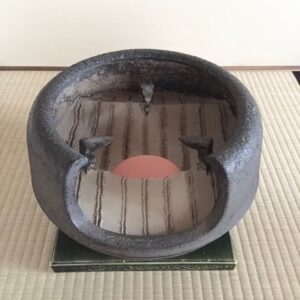
The ash pattern in the tetsu buro is called ni-mon-ji kaki-age bai, 二文字掻上げ灰, two-letter-character scratch-up ash. The lines, suji, 筋, are drawn with the hi-bashi, 火箸, fire-rods and are drawn with regard to the gotoku and the appropriately red mae-kawarake, for use in an iron furo. Nine lines are drawn in the ash, which may have symbolic significance. In keeping with the association of Buddhism and dragons, there are a group of nine dragons, the Ryū-sei kyū-shi, 竜生九子, Dragon-born nine-child. Dragons are rulers over water.
This design has nine parallel lines drawn on the ash bed from front to back, creating ten spaces. This style of ash bed pattern is usually prepared in a yatsure bu-ro, 窶れ風炉, timeworn wind-hearth, for the 10th month. Note the ceramic shiki-gawara, spread-tile, supporting the furo is Ori-be-yaki, 織部焼, Weave-guild-fired.
The 10th month is protected by A-mi-da Nyo-rai, 阿弥陀如来, Praise-increase-steep Like-become, the Buddha of Compassion.
The Naga King, Mucalinda, sheltered the Buddha from rain for seven days while he was deep in meditation. Mucalinda is depicted as a giant cobra with nine heads, with him in the middle. In some Buddhist sects, throughout southeast Asia that venerate naga, ナーガ, snake-like humans. There is no Kanji for naga, however, a connection may be drawn from the Japanese word nagai, 長, meaning long, and the major feature of a snake is its long slender body. Some traditions burn nine sticks at a time; including three sticks for three times, morning, noon, and night, totaling nine sticks.
Some Asian Buddhist sects burn 9 incense sticks, in association with worshipping the Naga gods and ancestors in San Phra Phum, Spirit House. In Chinese and Japanese these are called, To-chi Kami-ya, 土地神屋, Earth-ground God-house. Some large spiral incense coils burn for 190 hours, approximately 8 days.
Nine lines in Japanese can be written kyū-sen, 九線, nine-lines. This may be related to nine incense sticks, kyū–sen-kō, 九線香, nine stick-incense. In the Jōdo sect of Buddhism, incense sticks are laid down on a bed of ash.
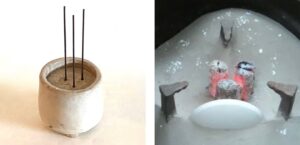
Left: kō-ro, 香炉, incense-hearth, ceramic cup with three feet, China, with three sen-kō, 線香, stick-incense, set upright in a bed of ash: the center stick is forward of the other two, and aligned with the front foot of the kōro. Right: fu-ro, 風炉, wind-hearth, with three pieces of burning charcoal, shita-bi, 下火, down-fire, with one piece in front of the other two, set in the middle of an iron go-toku, 五徳, five-virtues, and aligned with the front foot of the furo (not shown). Prior to putting the shitabi charcoal in the furo, three pieces of byakudan are laid in the center of the ash bed. Before adding charcoal, in certain procedures of building the charcoal fire, the front piece of the shitabi is moved behind the other two pieces, which changes the shōmen of the fire. With this move, the shitabi become aligned with the prongs of the tsume, 爪, claw, of the gotoku.
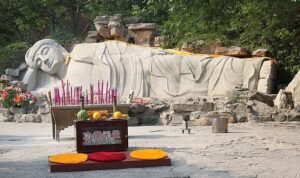
When the Buddha was dying, he asked that his bed be placed in the Sa-ra-sō-ju, 沙羅双樹, Sand-gauze twin-trees, so that he would lie with his head toward the north, as he faced the west, and the Goku-raku Jō-do, 極楽浄土, Extreme-pleasure Pure-land, the paradise of Amida. The word sara is the name of the location of the Sal grove. Sa, 沙, sand, is the origin of Sa-mon, 砂門, Sand-gate, that refers to Buddhist monks.
When offering incense in the Jōdo tradition, senkō is laid on an ash bed with the burning end directed to the left. The burning end may be likened to the head of the Buddha, whose head is in the North with his face looking West. This action places the person offering the incense in the west. When preparing Tea, the host faces North, and when placing incense in the hearth, the host is temporarily and metaphorically located in the West.
This change is reflected in a different way during the Nakaoki presentation, in the movement of the futaoki. The Nakaoki presentation is one of the few tenmae in which the shōmen of the futaoki is changed.
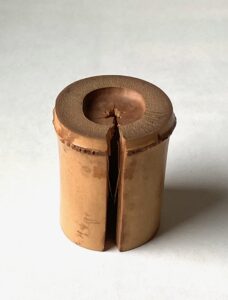
Aged bamboo take futa-oki, 竹蓋置, lid-place, moto-bushi, 元節, origin-node, of, ten-bushi, 天節, heaven-node, by Nishi-kawa Bai-gen, 西川煤玄, West-river Prunus-mystery, Taka-ga-mine, 鷹峯, Hawk’s-peak, Kyōto. If a bamboo futaoki cracks, as did the one in the photograph, the ware-me, 割れ目, separate-eye, becomes shōmen. Most seams, toji-me, 綴じ目, join-eye, are shō-men, 正面, correct-face, for round objects. A mnemonic for seams is ‘maru mae kaku muko,’ 丸前角向, round fore corner opposite.
When a mizusashi is placed directly on the tatami, the futaoki should be ao-dake, 青竹, green-bamboo. However, in the 10th month all green bamboo is substituted by aged bamboo. It is as though the aodake futaoki first used when the furo was used at the start of its season, which is called sho-bu-ro, 初風炉, first-wind-hearth, in early May. Many temporary bamboo utensils such as the futaoki and the hai-fuki, 灰吹, ash-blow, are made of green bamboo. Bamboo ages and turns gray to yellow or so-called ‘white.’ If an aged bamboo futaoki has the signature of a master or a design of some sort, then it may be displayed on a stand. There are, as always, glaring exceptions.

There is a furo that has a design of a mythical bird, the hō-ō bu-ro, 鳳凰風炉, (male) ‘phoenix’-(female) ‘phoenix’ wind-hearth. The furo has a wide shoulder and a relatively narrow opening, with little room for a go-toku, 五徳, five-virtue, trivet to fit inside. There are kama that have wide hane that rest directly on the furo shoulder, rai-ze, 塁座, wall-sit, or on small blocks of wood, suki-gi, 透木, rift-wood, placed on the shoulder of the furo. This style of furo has a long complex history with Omotesenke, and it was a favorite utensil, and adapted by Yū-gen-sai I-ttō Sō-shitsu, 又玄斎一燈宗室, Again-mystery-abstain One-lamp Sect-room, VIII generation Iemoto of Urasenke, It is also a favorite of Hōunsai, perhaps because of the similarity of the name ‘phoenix’. The furo has become known for having a kama in the form suggesting Mount Fuji, which may rest on sukigi on the shoulder of the furo.
One of the long traditions of Omotesenke is the use of a furo placed in the middle of the tatami, which is called Naka-oki, 中置, Middle-place. This is also present when displaying the furo on the formal display stand, dai-su, 台子, support-of. This manner of placing the furo in the middle of the tatami is presented at Urasenke, and at times on the daisu, and especially on the Go-gyō-dana, 五行棚, Five-transitions-shelf. In the 10th month Urasenke often places the furo in the middle of the tatami and often using the renowned yatsure-buro.
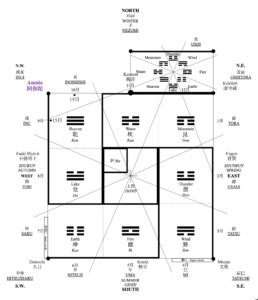
Diagram of a yo-jō-han, 四畳半, four-mat-half, cha-shitsu, 茶室, tea-room, showing the possible influences from the directions, calendar, Buddhism, I Ching/Eki-kyō, 易経, Change-sutra, Asian zodiac, etc. The ten-mae-za, 点前座, offer-fore-seat, where Tea is prepared, is in the upper-left corner of the room. The fu-ro, 風炉, wind-hearth, for Naka-oki, 中置, Middle-place, would is placed where lines would cross when drawn inward from the 15th of the 9th and 10th months. The 15th of each month is in accord with the full moon, which is the day, en-nichi, 縁壱, edge-day, when Amida is devoutly revered.
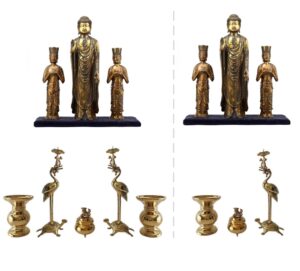
Two Buddhist altar arrangements of the offering utensils for a group of three dieties such as the A-mi-da San-zon, 阿弥陀三尊, Praise-increase-steep. The grouping on the left has the go-gu-soku, 五具足, five-tool-foot. The grouping on the right has the san-gu-soku, 三具足, three-tool-foot.
The kōro and incense are directly in front of Amida. Seishi on the left is the Yō, 陽, Yang, penetrative aspect of Amida, Kannon on the right is the In, 陰, Yin, receptive aspect of Amida. In the Sangusoku arrangement, the hitate/candlestick fire (Yō) is removed from Seishi; the water vessel (In) in the hanatate remains and is offered to Seishi (Yō). The hanatate/flower vase, water (In) is removed from Kannon; the fire vessel (Yō) in the hitate remains and is offered to Kannon.
The arrangement of utensils in the tokonoma is based on the Buddhist sangusoku. The hanatate, filled with water is placed, in front of Seishi who is on the left side of the tokonoma, that is the same location of the narrow mizusahi in Nakaoki. The hitate with its candle fire is placed in front of Kannon who is on the right side of the tokonoma, which is the same location as the chaire in Nakaoki.
Go-gu-soku, 五具足, Five-tool-legs, polished brass, for continued display on a Butsu–dan, 仏壇, Buddha-altar. The central feature is a kō-ro, 香炉, incense-hearth, with ‘lion’ topped lid, flanked by a pair of hi-tate, 火立, fire-stand, candlesticks in the form of a pair of tsuru, 鶴, crane, holding a pricket hasu no ha, 蓮の葉, lotus’s leaf, pricket candlestick, and standing atop a pair of kame, 亀, turtle. A pair of hana-tate, 花立, flower-stand, on the outside. These utensils provide the three essential Buddhist offerings of kō, ge, tō, 香華灯, incense, flowers, light.

Left: san-gu-soku, 三具足, three-tool-foot, Kara-kane, 唐銅, Tang-copper, hana-tate, 花立, flower-stand, kō-ro, 香炉, incense-hearth, hi-tate, 火立, fire-stand. Water Fragrance Fire.
Right: Naka-oki, 中置, Middle-place: hoso mizu-sashi, 細水指, narrow water-indicate, ceramic; mayu do-bu-ro, 眉土風炉, eyebrow earth-wind-hearth, ceramic with kama, 釜, kettle, iron, with bronze lid, placed on an ō-ita, 大阪, large-board; cha-ire, 茶入, tea-receptacle, ceramic, in silk shi-fuku, 仕覆, serve-cover.
There are Buddhist sects that display three of the utensils, san-gu-soku, 三具足, three-tool-foot; incense burner, candlestick, and flower vase. It is the sangusoku that influence the utensils used in the Nakaoki Tea presentation.
The ō-ita, 大阪, large-board, pictured above, is cut from the floor board where the ro is to be sunk into the floor. The ro-buchi, 炉縁, hearth-frame, measures 14 sun kane-jaku square, which means that the ōita is the same measurement. With Kyō tatami, the width is 25 sun kujira-jaku or 31.25 sun kane-jaku. Placing the 14 sun kane ōita in the center of the tatami square, leaves a measurement of 17.25 sun kane-jaku. Divided in half is 8.625 sun kane-jaku on either side of the board. Transposed to kujira-jaku, the measurement of is 6.9 sun kujira-jaku. The 6, roku, mu, 六, is symbolic of Infinity in Time. The number 9, kyū, ku, 九, is a homonym for kyū, 久, long time, and kyū, 救, salvation. Perhaps 6 9, roku-kyū is a metaphor for ‘infinite salvation’, or mu-ku, 無垢, no-dirt, Buddhist term, to be free from the impurities of worldly desires and to be pure.
For further study, see also: Aspects of Nakaoki, Kōgo for the Furo, Hakobi:Carrying Fire, Nakaoki Ōita, October and Nakoki, and Furo: Style and Form

